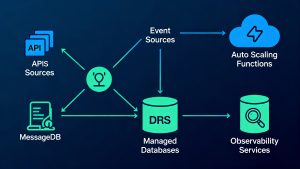Going by the current situation, systems and data are the backbone of nearly every business operation. From startups to large enterprises, everyone relies on IT infrastructure to deliver services, maintain communication, and store critical business information. But what happens when disaster strikes? Whether it’s a cyberattack, hardware failure, or natural calamity, the cost of downtime and data loss can be catastrophic.
A Disaster Recovery Plan (DRP) is a strategic blueprint that prepares organizations to quickly resume operations following disruptive events. It includes predefined protocols for data backup, system recovery, and infrastructure restoration. In software development, this plan is integral for ensuring application resilience, continuity, and minimal data loss.
What Is Considered a Disaster?
Disasters in software development and IT infrastructure come in various forms. These can range from natural disasters like earthquakes or floods to human-induced ones like data breaches, ransomware attacks, or misconfigurations. Some common types include:
- Cybersecurity Attacks – Malware, DDoS attacks, ransomware.
- Hardware Failures – Disk crashes, server shutdowns, and power failures.
- Software Failures – Bugs in production, memory leaks, deployment issues.
- Natural Disasters – Floods, fires, earthquakes that physically damage data centers.
- Human Error – Accidental deletion of critical files, misconfigured services.
For instance, if a cloud-based eCommerce app loses connectivity due to a DNS misconfiguration during deployment, and users can’t access their cart or checkout pages, that scenario would be considered a disaster if left unresolved.
Importance of Disaster Recovery
The impact of not having a disaster recovery plan can be devastating—both in terms of finances and reputation. According to Gartner, the average cost of IT downtime is $5,600 per minute. More importantly, 40% of small businesses never reopen after a disaster.
For software development teams, disaster recovery ensures that:
- Mission-critical applications are resilient to failure.
- System downtime is minimized.
- Client data is not permanently lost.
- Developers can roll back or recover to a previously stable environment.
- Compliance with data protection regulations is maintained.
How Does Disaster Recovery Work?
At a high level, disaster recovery works by automating the backup and restoration of systems, code, and data. Here’s how a basic flow might look in software development environments:
- Backup Process: Data is backed up to multiple storage systems or cloud buckets using tools like AWS Backup or Azure Recovery Services.
- Monitoring & Detection: Tools like Prometheus or Datadog monitor system health and detect anomalies.
- Triggering Recovery: When a failure is detected, automated scripts or infrastructure-as-code tools initiate recovery.
- Failover Systems: Traffic is routed to healthy environments using DNS failover or load balancer configurations.
- Rollback & Restore: Code and configurations are rolled back to the last known good state using version control or deployment automation.
Here’s a simplified example using AWS CLI to restore an EC2 instance:
bash
# Create AMI backup
aws ec2 create-image --instance-id i-1234567890abcdef0 --name "WebServerBackup"
# Launch instance from AMI
aws ec2 run-instances --image-id ami-abc12345 --count 1 --instance-type t2.micro --key-name MyKeyPairThis approach allows teams to automate recovery and reduce manual intervention during critical events.
Types of Disaster Recovery
There are multiple approaches to disaster recovery, each suited for different levels of preparedness and infrastructure setups:
- Backup and Restore – Traditional method where data is periodically backed up and restored manually or via scripts.
- Cold Site – A secondary site with minimal infrastructure; requires setup after a disaster.
- Warm Site – Pre-configured with hardware and software; less setup time but not real-time.
- Hot Site – Fully functional replica of the original environment; enables near-instant failover.
- Cloud Disaster Recovery (CDR) – Uses cloud providers like AWS, Azure, or GCP for scalable, automated DR.
Benefits of Disaster Recovery
Implementing a disaster recovery plan brings several advantages:
- Reduced Downtime: Automated recovery reduces Mean Time to Recovery (MTTR).
- Data Integrity: Regular backups ensure that data can be restored to a consistent state.
- Business Continuity: Ensures that services remain available even after major failures.
- Improved Client Confidence: Knowing that your systems are resilient can increase user trust.
- Regulatory Compliance: Many industries require DR plans to meet standards like ISO 27001, HIPAA, or GDPR.
Planning a Disaster Recovery Strategy
Designing a robust DR plan involves several components. Here’s how you can build a disaster recovery plan in a development environment:
- Risk Assessment
Identify potential threats—hardware, network, app layer—and assess their impact. - Define RTO and RPO
- RTO (Recovery Time Objective) – How fast systems should be recovered.
- RPO (Recovery Point Objective) – How much data loss is acceptable (e.g., 5 minutes of data).
- Prioritize Critical Systems
Not all systems require the same level of recovery. Focus on business-critical apps first. - Implement Infrastructure-as-Code (IaC)
Tools like Terraform or AWS CloudFormation can automate server, database, and network recovery.
hcl
# Terraform example to create an S3 bucket for backups
resource "aws_s3_bucket" "backup_bucket" {
bucket = "dr-backup-bucket"
acl = "private"
}- Automated Backups and Monitoring
Schedule regular snapshots and integrate alerts using tools like CloudWatch, Prometheus, or Grafana. - Testing and Drills
Run periodic DR simulations to test recovery time and improve team response.
What is Disaster Recovery Used For?
In a software development context, DR is essential for:
- Microservices Recovery: Rebooting services managed by Kubernetes or Docker Swarm during failures.
- Database Failover: Switching to replica databases during outages.
- CI/CD Recovery: Restoring failed deployment environments using rollback strategies.
- Codebase Versioning: Restoring previous code versions from Git during bad deployments.
- Compliance Audits: Demonstrating that recovery mechanisms exist and work as expected.
Consider this code snippet for rolling back a Git deployment:
bash
# Revert to the last stable commit
git reset --hard HEAD~1
git push origin HEAD --forceThis kind of code-level resilience is a critical part of DR strategies in DevOps workflows.
Conclusion
Disaster recovery is not just about backups; it’s about having a comprehensive plan in place to handle unexpected events with minimal disruption. As development teams increasingly adopt cloud-native, microservice-based architectures, the need for automated, code-driven disaster recovery becomes more pressing.
Whether it’s a server crash, data corruption, or a botched deployment, a well-implemented DR strategy ensures that your development team can respond quickly, restore operations, and protect business continuity. By integrating disaster recovery into your CI/CD pipeline, infrastructure code, and DevOps practices, you turn resilience from a backup plan into a competitive advantage.
For developers and DevOps teams alike, disaster recovery is no longer optional—it’s foundational.



